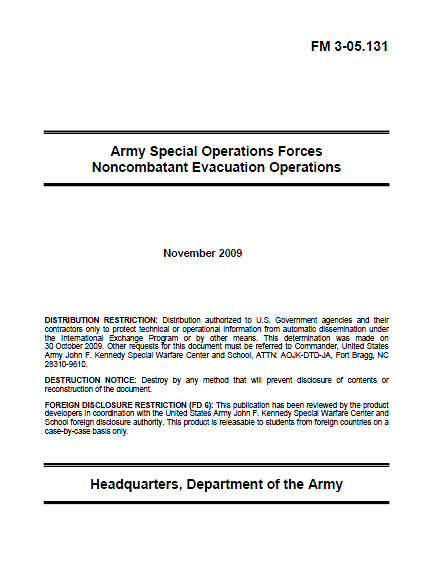The following manual was originally posted online on the file-sharing website 4shared.
FM 3-05.131 Army Special Operations Forces Noncombatant Evacuation Operations
- 124 pages
- Distribution authorized to U.S. Government agencies and their contractors only to protect technical or operational information from automatic dissemination underthe International Exchange Program or by other means.
- November 2009
Field Manual (FM) 3-05.131 establishes Army special operations forces (ARSOF) doctrine for planning, coordinating, and executing noncombatant evacuation operations (NEOs) across the entire continuum of operational environments. NEOs are inherently joint operations. History demonstrates that joint forces conducted the vast majority of NEOs. This manual describes ARSOF operating within that context, thus the content of this manual mixes joint and Army terminology where appropriate. This manual does not duplicate or supplant established doctrine dealing with tactical or strategic operations, but it does provide a specific framework to apply that doctrine. Commanders tasked to conduct NEOs should ensure that their planning staff is familiar with referenced publications.
…
NATIONAL POLICY
1-1. The DOS directs NEOs. During a NEO, the welfare of in-country U.S. personnel is the paramount consideration. However, the decision to evacuate the Embassy and the order to execute a NEO also affect political elements that may influence the timing of an evacuation. U.S. foreign policy objectives are the determining factor in the timing of an evacuation. The following paragraphs discuss the national policy concerning NEOs.
EXECUTIVE ORDER 12656
1-2. Pursuant to Executive Order 12656, Assignment of Emergency Preparedness Responsibilities, the DOS is responsible for protecting and evacuating U.S. citizens and nationals abroad and for safeguarding their overseas property. The DOS is the lead agency for planning and conducting NEOs. Executive Order 12656 also directs the Secretary of Defense (SecDef) to advise and assist the Secretary of State in preparing and implementing these plans.
EMERGENCY ACTION PLAN
1-3. Every U.S. Embassy and Consulate must maintain an emergency action plan (EAP). One section of the EAP covers the military evacuation of U.S. citizens and designated foreign nationals. The appropriate geographic combatant commander (GCC) reviews the EAP to ensure it is accurate and adequate to allow military support. Evacuation operations differ from other military operations in that the senior DOS representative directs the operation at the time of evacuation. The DOS representative’s order to evacuate is usually a political decision with extensive ramifications. The DOS or Ambassador may not give an evacuation order at the most opportune time. The representative may delay the order until the last moment to save political face by avoiding actions seen as a tacit admission of political failure. The DOS or the Ambassador may initiate the evacuation process or plan. Evacuation transportation options, in order of preference, are—
- Commercial transportation (already scheduled).
- Commercial charter.
- U.S. military charter.
- U.S. military transportation.
Note: Transportation options must be coordinated through the Washington Liaison Group (WLG).
EVACUATION GUIDELINES
1-4. The DOS or the Ambassador can order the following personnel to depart. These personnel are eligible for evacuation assistance. Once evacuated, the DOS and chief of mission (COM) must approve their return. Personnel in this category are—
- U.S. civilian employees of United States Government (USG) agencies, except mission-essential DOD employees of military commands.
- U.S. military personnel assigned to the Embassy, such as Marine security guards, defense attaché (DATT), and security assistance personnel.
- Peace Corps volunteers.
- USG contractors, if the contract provides for evacuation assistance.
- Dependents of those listed above.
- Dependents of other U.S. military personnel, including those assigned to military commands.
1-5. The DOS or Ambassador cannot order the following personnel to depart, but these personnel are entitled to evacuation assistance. They may return at their discretion and expense. These personnel are—
- U.S. employees of non-USG organizations.
- U.S. employees employed by or assigned to international organizations.
- U.S. employees that the host government directly contracts, even if the USG funds the contract.
- U.S. employees of private entities, such as relief organizations, even if the employer receives USG funding.
- Fulbright grantees and private U.S. citizens.
- Family members of private U.S. citizens, to include alien spouses, children, and other bona fide residents of the household.
- Other individuals the DOD designates eligible.
1-6. Legal, permanent U.S. residents (green card holders) are not entitled to any special assistance unless they fall into one of the above categories. As a rule, if the USG is controlling the evacuation, the priorities
for assistance are as follows:
- Priority I: U.S. citizens.
- Priority II: Alien immediate family members of U.S. citizens.
- Priority III: TCNs and designated foreign-service national employees of the USG.
- Priority IV: Seriously ill or injured eligible non-U.S. citizens in imminent peril as determined by the DOS (but who do not qualify for a higher priority).
- Priority V: Other individuals the DOS determines eligible.

